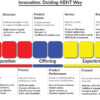
In the intricate medley of Indian mythology, the legends often carry profound messages that transcend time and culture. One such legend is the celestial collaboration between Sage Vyasa, the composer of the Mahabharata, and Lord Ganesha, the deity revered for his intellect and wisdom. The unique conditions of their engagement and the fulfilment of their duties offer timeless lessons on the importance of rules of engagement and unwavering commitment to one’s responsibilities.
The inception of the Mahabharata’s transcription was marked by a mutual agreement: Ganesha would serve as Vyasa’s scribe on the condition that the sage would recite the epic continuously, without pause. Vyasa consented, cleverly setting a condition of his own, ensuring that Ganesha comprehended each verse before etching it into permanence. This reciprocal stipulation laid a foundation for their tasks, emphasizing the essence of rules of engagement—not merely as formalities, but as structures enabling the harmonious alignment of collaborative efforts.
Ganesha’s swift penmanship, symbolic of efficiency and expertise, met its match in Vyasa’s strategic delivery of complex verses. These intricately composed sentences served a dual purpose: they allowed Vyasa brief respite and the space to conceptualize subsequent passages, and they challenged Ganesha’s understanding, ensuring quality and depth in transcription. This interplay between the two exemplifies the importance of intellectual engagement and strategic planning in any significant undertaking.
The legend takes a dramatic turn when Ganesha’s stylus shatters under the relentless pace of his writing. Unfazed, Ganesha breaks off a piece of his tusk, continuing to write without hesitation. This moment is a profound testament to the deity’s commitment to his duty, even in the face of unforeseen challenges. Ganesha’s act signifies that the fulfillment of a promise and adherence to responsibility should remain steadfast, irrespective of the obstacles.
Ganesha, known as ‘Ekadanta’ due to his single tusk, embodies the principle that in the pursuit of knowledge and the execution of duty, no sacrifice is too great. The breaking of the tusk is not merely a physical act but a metaphor for the sacrifices one may need to make in the service of a greater good.
The narrative of Ganesha and Vyasa goes beyond a historical or religious anecdote; it is a powerful allegory for the modern world. It teaches us the significance of setting clear rules of engagement in any partnership, which leads to mutual respect and understanding. It illustrates the importance of dedication to one’s roles and the willingness to adapt and sacrifice for the fulfilment of one’s duties.
In contemporary terms, whether in the boardroom or the classroom, the essence of the story remains relevant. The meticulous exchange between Ganesha and Vyasa encourages us to engage with our tasks mindfully, understand our roles fully, and commit to our responsibilities wholeheartedly. It is a reminder that while tools and circumstances may change, the integrity of one’s word and the honour of one’s commitment must remain unbroken—just as Ganesha continued writing, unswayed by the broken tusk.
In the legacy of this legend, we find a guiding light for personal and professional ethics, a beacon that reminds us that true wisdom lies in the balance of knowing when to pause and when to persist, and in recognizing that the true strength of a commitment is not just in making it, but in the relentless pursuit of seeing it through.
Prof. Dr. Prahlada N. B
12 November 2023
Chitradurga.

















Prahlada Sir 💐
Who among the two ? actually wrote
Mahabharata ….is a question of debate !
Though it is agreed upon by majority…. That the original version of Mahabharata, is ‘composed’ by Veda Vyas & scribed by Lord Ganesha , cleverly losing a tusk , to buy time & finish the task , at hand 🖐 .
Leaving that aspect as it is…..
If one thinks about the understanding & relentless pursuit of Veda Vyas & Lord Ganesha ….in finishing their assigned & committed task,
same can be applied to present day situation of commitment also …..requiring unwavering focus , discipline, consistent effort…..even when faced with challenges, setbacks or temptations to give up !
Prahlada Sir ,
ReplyYour intellectual fire 🔥 power , is great 👍 .
With a natural curiosity & a hunger to keep learning & growing, you help us to pursue a better world….with your beautiful blogs👌🏿🤩👏.